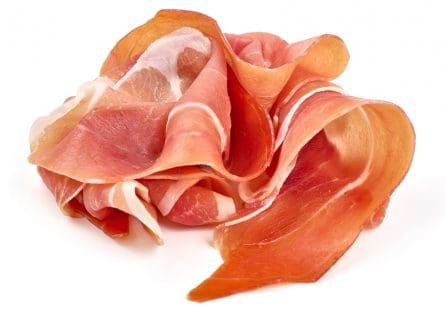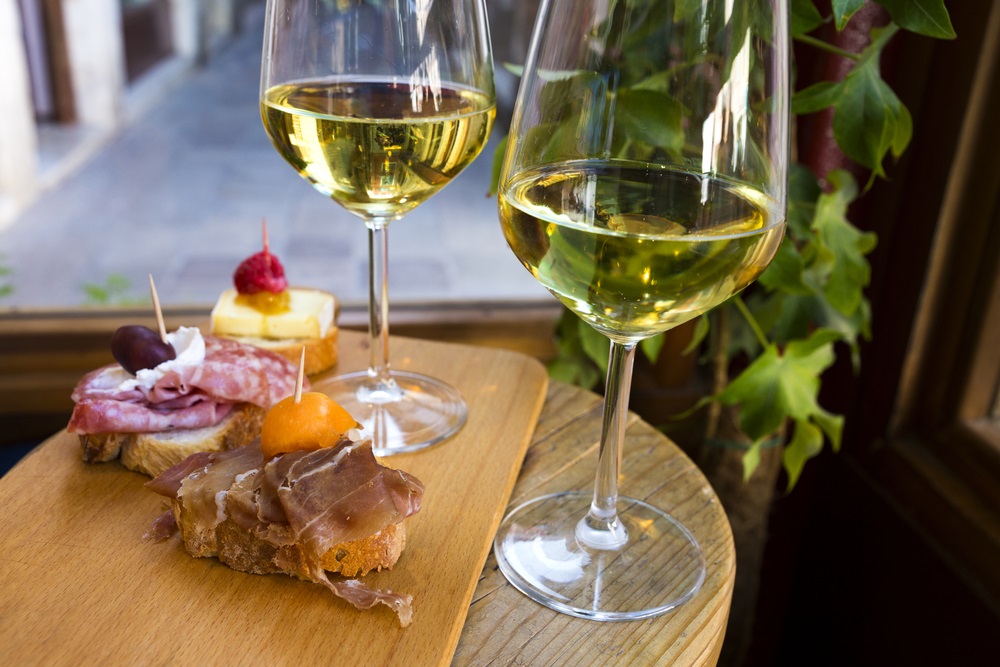
Uncover Italy’s Best Prosciutto: A Guide to Regional Varieties and Flavors
March 6, 2017
Explore Italian Prosciutto's diversity beyond Parma, with unique flavors and textures from regions like Tuscany and San Daniele.
By: Nicole Dickerson / Last updated: November 19, 2023
Estimated reading time: 7 minutes

Guide to Veneto Gastronomy and Cuisine: Read more
Regional Cuisine:
Belluno, Padua, Rovigo, Treviso, Verona, Vicenza
Home to the Venetian Lagoon and its enchanting namesake city, the province of Venice is full of culinary delights. The region’s rich gastronomic culture is primarily because the Port of Venice was historically a center for trade between Europe, Asia, and the Middle East. Here, Venetian cuisine represents the cultural exchanges of a former trading post and the region’s access to the riches of the Venetian Lagoon and the Adriatic Sea.
Baccalà mantecato is a traditional savory dish enjoyed throughout the Veneto, thought to have originated in Venice. Though Venetians have access to plenty of fresh seafood, they historically enjoyed preserved fish, too. This dish is made by first boiling salted cod in milk and water. Then, the fish is deboned and mashed into a creamy paste enlivened with garlic, olive oil, and parsley. Loaded with flavor, Baccalà mantecato is served on toasted slices of bread or with grilled polenta pieces.
Chioggia is a town that lies on the southern end of the Venetian Lagoon. Fishing is Chioggia’s main economic activity, as the town encompasses one of Italy’s largest ports. Broeto was created to utilize the daily catch that customers didn’t purchase or as a means for sailors to use the excess seafood on board. The fish soup consists of different types of fish, mollusks like shrimp, squid, baby octopus, mussels, clams, garlic, a Chioggia white onion, celery, carrots, and vinegar. Traditionally, broeto was served with bussolai or bussolà, which were thick breadsticks in a ring shape baked in the oven so they’d remain crunchy for a long time and not be affected by mold while out to sea. Today, broeto can be found served with polenta, too.
A dish famous worldwide, carpaccio, was first created in the 1950s at Harry’s Bar in Venice. Restaurateur Giuseppe Cipriani developed the dish for Countess Amalia Nani Mocenigo after her doctors recommended adding raw meat to her diet. Though many versions of carpaccio abound today, Cipriani’s original version consisted of super-thin slices of beef dressed with olive oil, lemon juice, and cheese shavings. An avid art lover, Cipriani named his creation after painter Vittore Carpaccio. The bold red color of the raw meat reminded him of the more colorful works of the artist.
Additionally, Venice is especially well-known for its cicchetti, or cichéti, in Venetian. These small Venetian plates are like Spain’s tapas-style dishes. Cicchetti is always seasonal and often includes olives, hard-boiled eggs, panini, or marinated anchovies. You’ll also find relatively more elaborate dishes like different types of polpette, baccalà mantecato, sarde in saor, various crostini, seafood, or meat in sauces.
For an authentic Venetian experience, head to one of the city’s bacari or small bars. First, ask for an ombra or drink, often a glass of wine or an Aperol spritz, and nibble on some Cicchetti. Then, when you’re ready to move on, or the bar gets too crowded, head to the next bacaro and repeat.
Fegato alla Veneziana prepares the calf’s liver, which involves sautéing the thinly sliced liver with caramelized onions. A splash of white wine, lemon juice, or vinegar is added to provide a sour contrast to the sweetness of the caramelized onions. Fegato alla Venezia is traditionally accompanied by grilled polenta.
For another simple Venetian seafood preparation that allows the sea’s flavors to shine, look to folpetti. This flavorful octopus dish involves first boiling the octopus with herbs and spices like peppercorns, bay leaves, and garlic. Then, cut the cooked octopus into pieces and season with salt, pepper, lemon juice, and a sprinkle of parsley to serve. So keep an eye out for folpetti, a tiny octopus, while hopping from one bacaro to the next in Venice.
A true delicacy of Venice, moeche are seasonal soft-shell crabs that you’ll likely find only at the Rialto fish market in spring or autumn. Skilled locals have harvested them from the Venetian Lagoon for over 300 years. For this Venetian specialty, the crabs must be harvested after they molt but before their new shells harden. Both male and female crabs molt in the spring, while only the male crabs molt their old shells in the fall. In Venice, moeche are prepared with seasoned scrambled eggs, which they absorb. Then, they’re dredged in flour and fried until golden brown and crispy. Finally, Moeche is served with a squeeze of lemon and a sprinkle of salt and is best enjoyed alongside a glass of Prosecco.
While risi e bisi highlights the land-based culinary traditions of the Veneto, risotto al nero di seppia embodies the seaside customs. First, squid is sliced and slowly braised with garlic, parsley, and white wine to make this Venetian dish. Next, rice is added to the pot to toast a bit before adding broth and squid ink. The latter gives a striking black color to the risotto and a salty, earthy flavor.
A Venetian classic, risotto di gò is prepared with the goby or ghiozzo fish from the bountiful Venetian Lagoon. This is a dish of humble origins because the goby fish is considered a poor fish mainly used for soups or risottos. It’s fatty and intensely flavored, making it the ideal fish for developing flavorful broths. Risotto di gò involves making a broth from the goby fish with celery, onions, carrots, and shallots. Then, the fish is removed and deboned while the risotto is cooked with the fish broth, dry white wine, and the fish meat. The risotto is finished with fresh chopped parsley to serve.
One of Venice’s most famous dishes, sarde in saor, was created for fishermen and sailors to preserve fish on their long voyages. The preparation involves frying fresh sardines and marinating them with vinegar, onions, pine nuts, and raisins. The name means sardines with flavor, referencing the sweet and sour flavors for which sarde in saor is known.
Though the name means seabass, baicoli are thin, slightly sweet biscotti created by a Venetian baker in the 18th century. Their elongated, flattened shape resembles that of their namesake fish. Baicoli is made with flour, butter, sugar, yeast, egg whites, milk, and just a pinch of salt. Since they have a long shelf life, historically, baicoli were taken on ships for long voyages. Today, they’re savored with coffee or zabaglione.
Venetian frìtole is a symbolic dessert of Carnival in Venice. The first mention of these golden globes of fried dough dates back to the 14th century. During Carnival, the fritolèri would line the alleys of Venice, selling their steaming hot donuts. The fritolèri were so prominent that they had a union to regulate them. By the 18th century, frìtole became the official sweet treat of Venice. The original recipe involves a dough made from flour, eggs, milk, raisins, and pine nuts. Each spoonful of dough is fried in a hot lard and then rolled in sugar while piping hot. The frìtole is a delightful street food delicacy infused with anise liqueur’s aromatic essence. It is served on wooden skewers, making them a perfect, easy-to-enjoy treat as you stroll through bustling streets. Today, you’ll find frìtole with custard, chocolate, and chantilly cream fillings.
These cookies are named for the Venetian word for yellow—zálo. Their yellow color comes from a cornmeal-based dough flavored with lemon zest and enhanced with rum-soaked raisins. Traditionally, zaletti is made without sugar, and a splash of grappa is added to the dough. They’re often enjoyed for breakfast alongside tea or coffee and are frequently savored for dessert.
While it’s a popular brunch cocktail today, the bellini was first created in Venice at Harry’s Bar around the 1930s. The cocktail is made with Prosecco and white peach nectar or purée. Restaurateur Giuseppe Cipriani also named this creation after an artist, the Italian painter Giovanni Bellini.
The Veneto Region in Italy offers a variety of experiences for wine enthusiasts. From the quaint wine villages of Valpolicella to the vibrant Prosecco wine country, the region is known for producing famous wines like Amarone, Prosecco, and Soave, making it a prime destination for those passionate about wine.
If you would like us to customize an exclusive luxury tour, contact us and let us know your travel plans. We offer luxury food and wine tours for private groups of a mininium two guests. In addition, all of our private, chauffeured tours are available year-round upon request.

